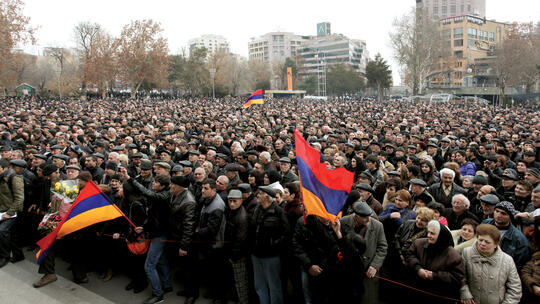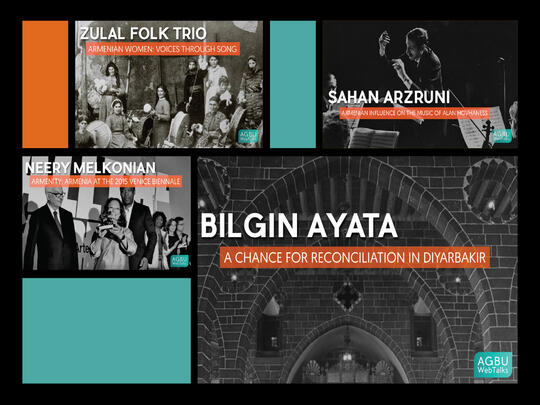On April 2, Armenia will hold parliamentary elections for the first time since voters endorsed constitutional reforms to transition the nation from a semi-presidential to a parliamentary political system. The two-year process will see the power of the president considerably reduced while strengthening the role of the prime minister and the parliament. Elected for a single seven-year term, the president will perform a largely ceremonial role as head of state, while executive power will shift to the prime minister, who will be nominated by a parliamentary majority.
Current President Serzh Sargsyan justified the new political structure as a path towards a more accountable government and an increase of public influence on policymaking. But much of the Armenian population remains skeptical, believing the electoral changes were engineered to extend the president’s hold on power beyond the end of his term. The forthcoming parliamentary elections will be a critical test of the effectiveness of Armenia’s constitutional reforms and will set the stage for the transfer of power when Sargsyan’s term expires in 2018.
April’s parliamentary elections could also be more unpredictable than expected. Under the revised constitution, the Armenian Parliament will now be elected based on the principle of proportional representation. The number of seats that a party wins will be proportional to the amount of its support among voters. For instance, in a ten-member district if a party wins 50% of the vote, the party would be allotted five seats. Advocates of proportional representation argue the system tends to be more representative, reduces partisanship by promoting more collegial cross-party decision-making, increases voter turnout, and boosts the representation of women and of marginalized groups in parliament. It is the preferred voting method among the majority of European nations, and has been successfully adopted in Georgia, Moldova and Ukraine.
Critics of proportional representation contend, however, that it can also result in shaky coalition governments plagued by decision-making paralysis in a hung parliament, where no single party has a majority of seats. Israel is often cited as the model of what can go wrong. Successive governments in the Israeli Parliament, or Knesset, have often paid a steep price for forming coalitions with radical minority partners who then wield a disproportionate amount of power, hampering the efforts of a prime minister seeking compromise and concessions—a precarious situation that has led to a mid-term collapse of the government and early elections.
Majority Rule
Could Armenia face such a scenario? On April 2 voters in Armenia will elect 101 members (reduced from 131) through a complicated mixed, or two-tiered, proportional system comprised of both a national list and 13 district lists of candidates. For the first time, four additional seats will be reserved for national minorities: Russians, Yezidis, Assyrians and Kurds. In order to form a stable majority government, a party or alliance must win 54% of the seats. If no party or alliance obtains a stable majority, six days are allotted to form a coalition government that reaches the majority threshold.
During the last parliamentary elections held in 2012, the Republican Party of Armenia (RPA) won 44.78% of the vote in proportional districts. Compounded by growing public dissatisfaction with the government over the past five years, the party cannot hope to win a majority without a coalition partner. Accordingly, the RPA struck a deal with the oldest Armenian party, the Armenian Revolutionary Federation, or Dashnaktsutyun. In exchange for its support, the Dashnaktsutyun were rewarded with three ministerial offices and three governorships, a disproportionate allocation of positions compared to the limited number of its members in the parliament.
While it is expected that the Republican Party will win a majority, how the political structure will take shape and who will lead the party after 2018 is unclear. As Senior Carnegie Fellow Thomas De Waal has noted, the Parliamentary elections could be “a lot livelier than anticipated. The new constitutional change frees the opposition from a straitjacket in which it has been struggling for years: its lack of a credible individual who could be its presidential candidate in 2018. Now, the opposition’s challenge is slightly less daunting: to build a proper party machine capable of taking on the ruling Republican Party in two years’ time.”
The main opposition parties currently comprise Prosperous Armenia, Armenian National Congress, Rule of Law party (RLP) and Zharangutyun (Heritage). In December three other opposition parties, Civil Contract, Bright Armenia and Republic, partnered in an alliance to jointly challenge the government in this spring’s parliamentary elections. According to their memorandum, the parties will strive for “a European model of the democratic rule-of-law and social state” in Armenia. Former Foreign Minister Vartan Oskanian’s Hamakhmbum (Consolidation) Party together with the Third Republic Party and the Democratic Party of Armenia (HDK)—also both headed by veteran politicians—announced their own coalition, pledging to work toward “systemic changes in political and socioeconomic areas.” The new opposition bloc may also be joined by the Heritage Party.
Cooperation or Chaos?
Will Armenia’s system of proportional representation result in a more democratic system of governance marked by greater power-sharing between political parties? Or will the country suffer from a lack of unity that defines the Israeli Knesset? Neither scenario is likely in the short term according to political scientist Stepan Danielyan, who notes that despite the socio-economic conditions in Armenia and widespread popular discontent, the governing party enjoys full control over local politics while the opposition remains weak, lacking the financial and human resources to consolidate their power. “The precondition for marginal parties to enter the parliament is to agree to playing a proxy role for any major party prior to the elections, which is what is actually taking place now in Armenia,” he told AGBU. “The struggle for power is happening within the governing parties, while marginal parties are simply observers.”
The precondition for marginal parties to enter the parliament is to agree to playing a proxy role for any major party prior to the elections, which is what is actually taking place now in Armenia
Following the constitutional amendments, the president will be weaker but many political observers have cautioned that the tradition of a single-party regime will remain in force as long as President Serzh Sargsyan is able to retain control over the party. “I do not see sound grounds for real change in 2017,” affirmed Heritage Party Member of Parliament and Executive Director of the International Center for Human Development, Tevan Poghosyan. “The functioning of the Armenian Parliament and politics generally depends not so much on the model of its formation, but the people who are in the Parliament. Are they going to implement their election programs? Are they going to take all the opportunities provided by the Rule of Procedure?”
In order to break with the past’s single party regime marred by allegations of abuse of administrative resources and electoral fraud, Poghosyan believes Armenia will have to wait until the 2022 elections, by which time he expects a generational change will positively influence Armenian politics. For now he is hopeful that the spring elections can at least sow the seeds of political development towards an effective power-sharing parliamentary model.
Proportional representation is not a guarantee of fair elections. It will likely take more than one election cycle to realize meaningful democratic change and accountability. However, regardless of the political motivations underpinning Armenia’s transition toward a parliamentary republic with proportional representation, the shift is an important potential step toward a future where different visions for the development of Armenia can compete in the political arena. In the long term, Armenian civil society—which, with the exception of a few concessions, won by protest, has spent the past 25 years largely as bystanders in the political process—will benefit. The path forward is gradually emerging for a strong civil society for whom expectations of effectively participating in the democratic process will only grow.











